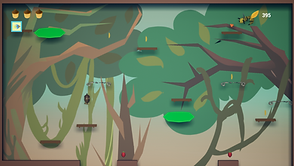
Single Player | 2D Fixed View | Platformer
10 Person team - role: Blueprinter & game designer
January 2023 -
May 2023
Acorn Adventure is a fixed camera platformer that is reminiscent of early video game adventures from the 70’s and 80’s. The object of the game is to travel through the inside of a tree, defeat the wasp nest, and earn a high score.
For this 48-hour competition, “Roots” was the theme given to teams. In addition to literal roots, our ten-person team decided our game should be a throwback to the roots of the game industry. The character can run, jump on enemies, and collect power-ups to shoot projectiles and to double jump.
I was the primary game designer and blueprint programmer. I built the underlying system used by the main character and the main Blueprint Interface, as well as specific enemies. After Game Jam was over, we refined the game for submission to SCAD’s Entelechy Competition.
Arcade Inspiration
.png)
Since the theme of the 2023 Global Game was 'Roots' we decided to draw upon the style of single-screen arcade video games.
From this we decided to focus the game around platforming, and decided the goal of the game was to earn the highest score possible.
The game elements referenced classic elements of early games. The player could climb vines as ladders, could bounce of the top of enemies, pick up leaves to earn points, and had to avoid spikes and bottomless pits. The arcade origins also inspired the power-ups:
double jump, projectile launch, health restore, and brief invincibility.
Central BPI
To keep interactions simple, the code makes use of parent classes utilizing a singular Blueprint-Interface. Both enemies and the players relay damage to each other through the BPI, with an enumerator determining the 'type' of damage - enemy attack, jump, invincible, projectile, or fall. This keeps the interactions streamlined and easy to fix.
The BPI is also used by the power-ups to inform the player they have been collected, or that the player's score has increased.
Development Process
Concept & Setup
.png)
.png)
Our team was formed one week before the Jam and consisted of both graduates and undergraduates. Having only 48 hours, we had to quickly decide on a concept and begin production. After our initial concept, we reviewed early games - Donkey Kong, Pac-man, and Space Invaders – to determine core elements. Knowing how important scope is to a successful jam project, we kept the movement inputs simple. The main characters had to be able to walk, jump, and climb ladders, with power ups to allow them to be briefly invincible, double jump, and shoot projectiles.
As the main programmer, I created an interaction system using a Blueprint Interface that managed both power ups and damage. To keep the game arcade-like, I developed an actor that tracks when the player dies and instantly resets the level elements such as enemies and platforms. I implemented other blueprint actors such as ladders.
There were major interruptions during the first 24 hours. The school Perforce server had an issue that locked everyone out from 9 pm the first night to noon the next day. We continued working with the source control down, but it made certain elements develop differently since sharing was impossible.
Halfway through
.png)
.png)
.png)
As the first 24 hours ended, we began moving onto later portions of development. As I finished each element, I passed them to the level design team. On the last night, we began implementation of the animations and finished models as the art team completed them. The core of the system was fully programmed at this point, and I began setting up the basic UI widgets and menus. As we passed midnight, the majority of us retired to get some rest before the last day.
The final day, I spent my morning finishing the boss blueprinting and adding the 2D UI and menu assets into the game. SCAD's game jam site emphasizes submitting a gameplay trailer for judging as part of the competition after the jam ends. With five hours to go, we collected footage from the current version of the game and tasked one member to create a trailer. As we were implementing assets, we repeatedly built the project in Unreal and made sure it was still functional. With one hour to go, we created the final build that included the main menu, instructions, and five levels with one boss battle.
Acorn Adventure Game Jam Trailer
Reflection
Overall, I am proud of the team. We had varying levels of expertise and experience with a game jam, but we came together amazingly well. There were issues such as the Perforce server outage, power failing in a classroom, and animation glitches. We followed through on the original plan, and our end product matched the original intended scope. The game is simple, but in 48 hours, we created a complete five-level game with a working executable that we made us proud.
Refinement
During Spring of 2023, we refined the game for submission to SCAD's Entelechy competition. We discussed ways to improve the game and settled on leaning into the arcade aesthetic and made several changes. The game now has a life system where players have five lives to make it through all levels. On death, they can return to the main menu, or continue from their current point if they prefer, but the score resets. A timer was added, and players score higher the faster they make it through each level. When a player destroys an enemy, the points earned briefly appear next to them, similar to Super Mario Bros 3. A final addition was in the game's scoreboard where now a player can enter their 3-letter name and see the top five players when done.
.png)
.png)
.png)
.png)








